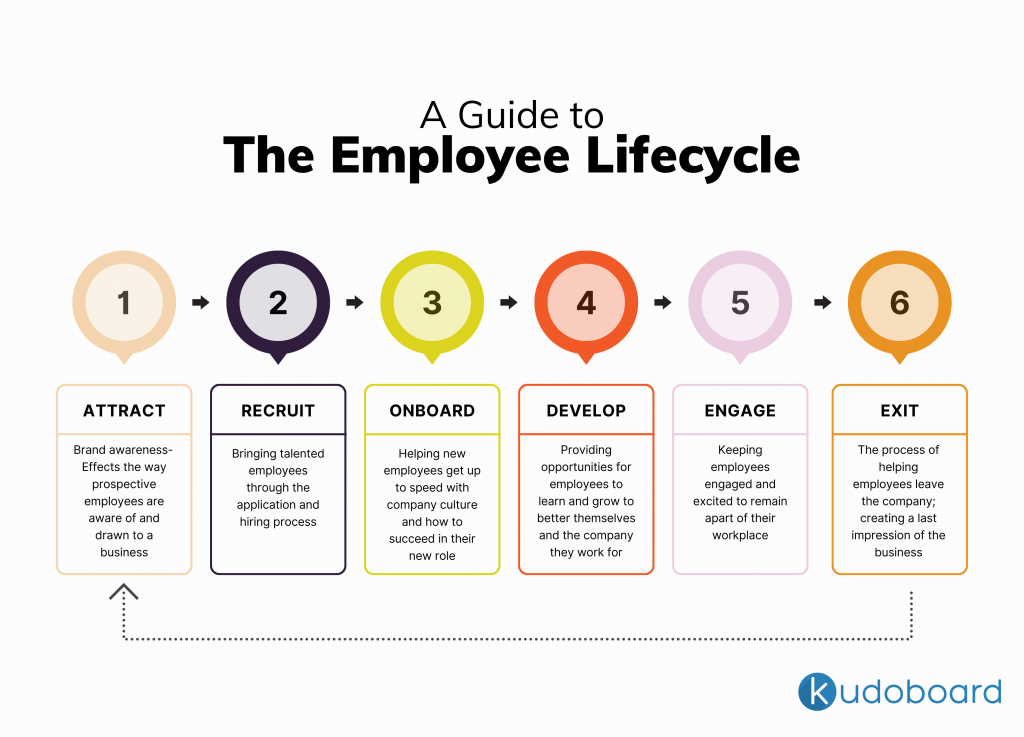It’s no secret that today’s workplace looks far different than it did 10 years ago. Technology is rapidly changing, we have better standards for diversity and inclusion, and flexible work arrangements are becoming more commonplace. The Covid-19 pandemic created a huge push for remote positions which is changing the possibilities for how work is done. The customer experience has always been a key focus for every company but in the last few years leaders are waking up to the understanding that employee experience is just as important (if not more so). Organizations are investing time and money into creating a company culture that prioritizes its workers and finds ways to improve the employee experience.
What is the Employee Experience?
Employee experience, commonly referred to as “EX,” is the sum of everything an employee experiences throughout their time in a company. This overall experience encompasses every aspect of the workplace and work environment, such as the company culture, the hiring and onboarding process, salary, benefits, relationships with management and coworkers, growth opportunities, and so much more. Though some smaller parts might seem insignificant, each piece is necessary for a strong employee experience. A helpful framework for understanding this topic is something called the “Employee Experience Equation.”
The Employee Experience Equation

To improve the overall employee experience, you have to first understand what it is. An equation used for that is:
Technology + Culture + Physical Space = Employee Experience
Let’s take a closer look at each one and see what part it plays in the employee experience equation:
Technology
The technology used within an organization makes up 30% of the employee experience. Every year that passes brings new technology into the workplace and shifts older tech into an outdated graveyard of the past. How technology is used and what tools employees are offered makes a big impact on how they feel about their job. This includes things like computers, software, apps, etc. For a business to have a strong employee experience they don’t have to be on the front lines of offering the newest and latest shiny tech to their employees, but the more outdated their tools are, the more negative the impact will be. Outdated tech makes it harder to get various jobs completed and it takes up time that can be spent on other things. Having modern technology that is user-friendly, efficient, and supportive allows employees to feel more engaged in their work and experience higher levels of employee satisfaction.
Culture
Company culture accounts for 40% of the employee experience. It is not one specific thing or a singular plan put in place, but rather a system that operates in the background of the workplace. Company culture is created from the goals, practices, attitudes, and overall vibe of the organization. The type of culture that is running in the background of a business will largely determine whether or not the employee experience is positive or negative. It will include things like leadership and management styles, relationships between coworkers, interactions with customers, workplace engagement, productivity levels, work-life balance, and how decisions are made within an organization. All of this together creates a sense of “personality” for a business and will impact individuals in, out, and around the company.
“Corporate culture is what energizes us or drains us, it motivates us or discourages us, it empowers us or it suffocates us.”
Jacob Morgan
Physical Space
The physical space portion of a company makes up 30% of the employee experience equation. Everything an employee physically experiences in their workplace will factor into this piece of the puzzle. Just like we design our homes to feel comfortable, functional, and enjoyable, the same careful thought should apply to the workplace. The physical space of a company refers to things like office layout, decorations, lighting and temperature, noise levels, and office “perks” like a gym or cafeteria. Research shows that the characteristics of the physical workspace have a large effect on employees and will impact their mood, performance, and satisfaction. Some interesting findings of that research include:
- Employees were less tired and had better attention and focus when they are around living plants and window views
- Regarding the temperature inside the office, for every degree over 25°C (77°F) productivity decreases by 2%
- Various wall colors are better suited for certain jobs (Blue for concentrating on numbers, green for management, and yellow for sales), and if “unsuitable colors” were used there were higher levels of stress, depression, or boredom among employees.
Each of these three pieces, technology, culture, and physical space, together create a helpful tool in understanding the employee experience, as well as ideas of where to improve.
Why is Employee Experience Important?
Looking closer into each part of the employee experience has shown researchers and businesses worldwide that the decision of whether or not to invest in a strong employee experience strategy can make or break a company. A great employee experience overall produces significant benefits for the employees and the organization. Some of those benefits include:
- Higher employee retention rates, as well as reduced employee turnover due to regrettable attrition
- Better teamwork and camaraderie
- Stronger company culture
- Higher levels of engagement and productivity
- Better customer experience
- Increased innovation and creativity
Read More: Why Employee Experience Matters
5 Signs You Need to Improve Your Employee Experience
Glancing over the benefits listed above makes it obvious why over 90% of HR leaders say employee experience is a top priority. You know it’s important, but how do you know if your company has a good employee experience or not? Here are 5 signs that you might need to improve your employee experience:
- Not Enough Workplace Recognition
One of the most important things you can do to retain talented employees is to make them feel valued and appreciated. There are countless ways to show workplace appreciation and to recognize employees for their hard work, and if this area is not a priority, it needs to be. According to a Glassdoor survey, 53% of people said they would be willing to stay longer at a company if they felt more appreciation from their boss.
- Lack of Meaningful Challenge
Employees want to feel like the time they spend at a job is helping them to grow both in their careers and as an individual. Feeling bored and disengaged because of repeatedly performing monotonous tasks that don’t feel important will undoubtedly lead to higher turnover rates. Talented workers leave their jobs every year due to a lack of growth and opportunities within their careers. Having some degree of challenge can motivate employees, increase job satisfaction, and create more engagement in the workplace.
“The #1 reason people change jobs today is career growth opportunities”
-Gallup
- Toxic Work Environment
Having a toxic work environment is unfortunately easy to find and is a huge factor in the “great resignation” trend we are seeing in the current job market. It’s important to get regular feedback from employees to know how they feel about the environment they are working in. If the employee feedback you receive repeatedly mentions things like burnout, too much competition, gossip, drama, or lack of diversity and inclusion, then you might need to reassess your company culture and find ways to make changes.
“A toxic culture is 10.4 times more likely to contribute to attrition than compensation.”
- Fear of Layoffs
Nothing kills employee morale and engagement quite like the fear of being laid off. Layoffs are one of the most stressful events that occur in someone’s life and knowing your company has a history of layoffs or rumors that they might occur, can send employees running and weaken your employee experience reputation. Harvard Business Review showed that downsizing a workforce by just 1% causes an increase in voluntary turnover by 31%. If this sounds familiar and applies to your business, chances are your employee experience strategy needs to be revisited.
Read More: 5 Negative Effects of Layoffs
- Lack of Technology
We already discussed above how the technology used by a company makes up 30% of the employee experience. Ignoring the rapid changes in technology and refusing to make shifts are huge factors in how your employees feel about their job. If your company isn’t investing in ways to use newer workplace technology to streamline job processes, free up time spent doing unnecessary tasks, and make the day-to-day tasks more enjoyable, then your employee experience will suffer as a result.
If any of those 5 signs resonated with your company, don’t panic. Yes, there is some work to do, but you don’t have to figure it all out on your own. Recognizing that there is a problem and being willing to make the necessary changes already puts you one step ahead of many other company leaders. If you are ready to invest in shifts for your employee experience strategy, then we’ve got your back. Below are 10 ways to improve the employee experience.
10 Ways to Improve Employee Experience
- Understand the Employee Lifecycle

Familiarizing yourself with the employee lifecycle, or the employee journey, is a great place to start when looking to create a strong employee experience. This framework helps identify each stage employees will go through during their time at a company, and highlight areas of excellence or ones that need improvement. It walks you through each of the 6 steps of the journey (attract, recruit, onboard, develop, engage, and exit), and can point you to things you might have overlooked. For example, you might realize you aren’t measuring up in the “develop” stage and losing employees who feel they aren’t being given the chance to grow. Or, maybe you recognize that the technology you are using in your onboarding process is leaving new hires frustrated and confused. Knowing where your weaknesses fall on the lifecycle framework helps to identify where you should place your best efforts for improvement.
- Be Flexible
One surefire way to make a positive impression on your organization’s employee experience is to incorporate a more flexible schedule and environment. Previously it was rare to find a position offering something other than an 8-hour workday performed 5 days a week in the office. However, thanks to the worldwide upset during the Covid-19 pandemic, many employees are requiring a remote or hybrid schedule to commit to a job. Flexibility, at its core, is about providing the circumstances where your employees feel they are at their best. Both employers and employees have seen in the last few years that success occurs in many settings and it allows trust to build between the two. As time goes on and more companies shift to a more flexible model, organizations that hold tight to a rigid schedule will watch as competing organizations pass them by – likely taking the best talent away with them.
“We’re in the midst of a workplace revolution and, as a result, employees are in the driver’s seat, and with that comes a shift in how leaders need to show up.”
– Meg Newhouse, CEO of Inspirant Group
- Give More Recognition
Relying on compensation isn’t enough anymore to attract and retain talent. Using bonuses and an emailed “thank you,” deprives your organization of life and motivation beyond a dollar amount. Adding genuine connection and emotion into the workplace is necessary to withstand things like the Great Resignation. It doesn’t have to be hard though, there are plenty of options for recognition and workplace appreciation, which makes it easy to find something that fits your style. One example is creating a shout-out board from Kudoboard for your employees. It is quick and easy to make and makes someone feel seen and valued. Use it to highlight someone who has gone above and beyond, a “group” board for a handful of achievements from the month, or even for birthdays and anniversaries. The options are endless and allow you to customize the recognition for your company and employees, which makes it easier to choose what will work best to improve your employee experience.
- Make it Fun
Just because it is work doesn’t mean it has to be boring; keep your employees excited about their job, and have a positive impact on their employee experience, by bringing some fun into the workplace! Of the companies ranked on “great places to work” lists, 81% of employees said they had a fun work environment, which means “fun” should be woven into your company culture. The good news is this isn’t hard to do; there are so many ways to have fun together as a team, regardless of whether you do so in person or remotely! Play games, take an art class, go to an escape room, take turns choosing the music, take advantage of things like March Madness, or host fun holiday parties. Whatever you choose, as long as it involves things your employees are interested in, will create better engagement, job satisfaction, and overall employee experience.
- Create Work-Life Balance
Requiring employees to put in long hours might seem like a great idea for profits, but countless research shows otherwise. Not only does it cause more stress and harm to the workers, but it also doesn’t even increase profits.
“Managers could not tell the difference between employees who actually worked 80 hours a week and those who just pretended to.”
– Erin Reid
The unnecessary stress of being overworked leads to burnout and a host of health problems that will negatively affect the company. Some of those include substance abuse, issues with sleep, anxiety, depression, diabetes, and heart disease. It’s easy to see how these can quickly snowball into complications that put a strain on your employee experience strategy. To improve in this area there needs to be a shift in priorities to create more work-life balance. It will require collaboration from both the employer and the employee, but encouraging this shift will allow your employees to feel supported and safe in making the necessary changes. Some companies are doing this by emphasizing proactive rest. Rather than waiting for the employees to work themselves into burnout and hope they will use their PTO, they are starting to adjust their policies so that more breaks and flexibility are worked into the workplace schedule. One company even combined the “make it fun” suggestion seriously and combined it with this shift into proactive rest. Since it is a mattress and furniture company, they created a “Right to Nap” policy between 2-2:30 pm where employees were not allowed to work and encouraged to take a nap. Employees who work for a company that prioritizes their mental ad physical well-being have a much higher chance of a positive employee experience.
- Celebrate the Little Things
Improving the employee experience doesn’t have to only include making large and grandiose changes. One small way to make a big impact is to create a company culture that celebrates the little things. Celebrating birthdays, anniversaries, and holidays are popular choices that many employees enjoy. Employees are happier and more engaged when small wins are celebrated regularly so it makes sense to, publicly or privately, make the effort to acknowledge and express appreciation when that little victories occur. Many companies find Kudoboard to be an easy and effective way to do this in their workplace. Making an online group card for coworkers on their birthday, or posting fun and supportive “congrats” for various employees is a small gesture that packs a big punch. And the best part is it takes less than 10 minutes to set it up!
- Invest in DEI
According to research in the workplace, over 70% of companies are predominately white, and those who make up the BIPOC demographic don’t feel part of decision-making within the company. This is why organizations need to prioritize diversity, equity, and inclusion (DEI). This includes seeking out talent that includes differences in:
- Race and ethnicity
- Gender identity and sexual orientation
- Socioeconomic classes
- Those who do and do not have children
- Physical abilities
When organizations make this a priority, they not only help to make societies more inclusive and safe, but they make a big difference from a business standpoint. Having diversity means more perspectives; when you have people from different backgrounds it allows for greater innovations and approaches that are simply not possible when everyone looks and thinks the same.
- Create Better Communication
A great way to assess the health of your company is to look at the quality of communication within the workplace. Communication issues are detrimental to any relationship and the same applies to a manager or team member. Strong internal communication directly correlates to workplace engagement and productivity, as well as job satisfaction. Conference Board shows that companies can lose up to $450 billion (a year!) because of disengagement, decreases in productivity, and turnover. Improved internal communications can play a big part in preventing this. Here are a few suggestions of where to start:
- Gather regular feedback from employees. Ask them if they are happy with the technology used or the growth opportunities offered. Let them be a part of deciding what training would help them improve or advance in the areas which are important to them.
- Build better communication skills among leaders. Managers, human resources, and other leaders are the ones who set the tone for communication in the workplace. Invest in ways to improve what you already have, and create a better foundation for those who will join the company.
- Spend time getting to know employees. We are all more likely to want to be engaged, as well as feel safe speaking up about problems we are having when we feel comfortable with the people we work with. Providing ways for coworkers to get to know each other, as well as prioritizing understanding how your employees feel comfortable communicating (face-to-face, email, an employee survey, etc.) will greatly improve communication overall.
- Improve Onboarding Process
Onboarding is the chance to set employees up to succeed and shouldn’t be taken lightly. Substandard onboarding can lead to less confidence and a higher risk of turnover, whereas effective onboarding makes employees three times as likely to go on to have a positive employee experience. Take time to consider whether your current onboarding process is working (especially if your onboarding is virtual) or if there are things you can improve. Hiring an onboarding specialist to be a part of your human resource and employee experience management team is a great way to invest in a strong onboarding process. It gives the tasks involved in acclimating new hires to someone who can give their full attention to the job. This can make a big impact on the overall employee experience.
Read More: Do You Need An Onboarding Specialist?
- Better management
Gallup states that “the manager-employee relationship is the most important relationship at every stage of the employee experience,” because they have a direct impact on how their employees will engage with the position and how supported they feel in their growth.
“The manager alone accounts for 70% of the variance in team engagement.”
Gallup
For a company to succeed, the employee experience strategy must include developing great managers. This doesn’t just mean hiring “nice” managers, although that is a bonus. A good manager is someone who can understand and care about their employees and has the skills to coach them in their position. Investing in this type of leadership is invaluable and will have a lasting effect on productivity, engagement, job satisfaction, and overall employee experience.
Conclusion
Employee experience matters and is worth the time it takes to create a strong one. Not only will it change the way your company operates, but it helps to create a company culture that people want to be a part of. By using some of the suggestions above you can easily start to see shifts in your employee experience that will result in lasting positive changes for you and your company.




